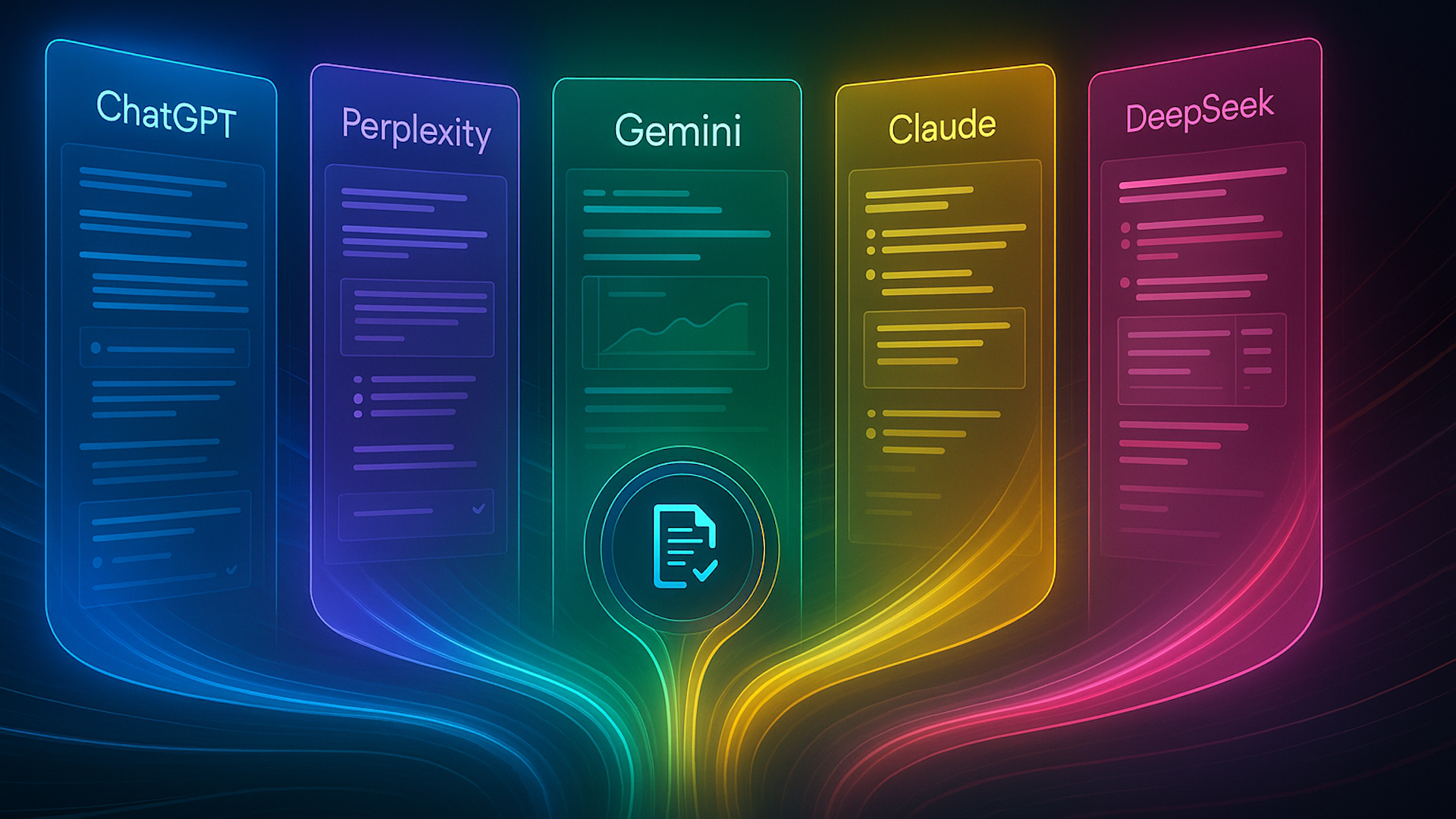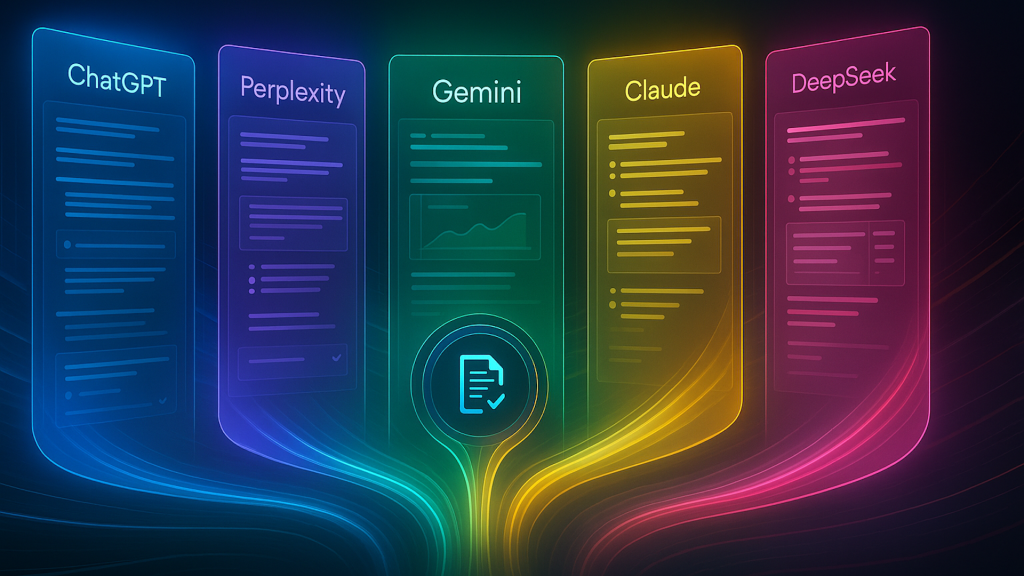How different AI engines generate and cite answers

Generative AI is no longer a single thing.
Ask, “What is the best generative AI tool for writing PR content?” or “Is keyword targeting as impossible as spinning straw into gold?,” and each engine will take a different route from prompt to answer.
For writers, editors, PR pros, and content strategists, those routes matter – every AI system has its own strengths, transparency, and expectations for how to check, edit, and cite what it produces.
This article covers the top AI platforms – ChatGPT (OpenAI), Perplexity, Google’s Gemini, DeepSeek, and Claude (Anthropic) – and explains how they:
- Find and synthesize information.
- Source and train on data.
- Use or skip the live web.
- Handle citation and visibility for content creators.
The mechanics behind every AI answer
Generative AI engines are built on two core architectures – model-native synthesis and retrieval-augmented generation (RAG).
Every platform relies on a different blend of these approaches, which explains why some engines cite sources while others generate text purely from memory.
Model-native synthesis
The engine generates answers from what’s “in” the model: patterns learned during training (text corpora, books, websites, licensed datasets).
This is fast and coherent, but it can hallucinate facts because the model creates text from probabilistic knowledge rather than quoting live sources.
Retrieval-augmented generation
The engine:
- Performs a live retrieval step (searching a corpus or the web).
- Pulls back relevant documents or snippets.
- Then synthesizes a response grounded in those retrieved items.
RAG trades a bit of speed for better traceability and easier citation.
Different products sit at different points on this spectrum.
The differences explain why some answers come with sources and links while others feel like confident – but unreferenced – explanations.
ChatGPT (OpenAI): Model-first, live-web when enabled
How it’s built
ChatGPT’s family (GPT models) are trained on massive text datasets – public web text, books, licensed material, and human feedback – so the baseline model generates answers from stored patterns.
OpenAI documents this model-native process as the core of ChatGPT’s behavior.
Live web and plugins
By default, ChatGPT answers from its training data and does not continuously crawl the web.
However, OpenAI added explicit ways to access live data – plugins and browsing features – that let the model call out to live sources or tools (web search, databases, calculators).
When those are enabled, ChatGPT can behave like a RAG system and return answers grounded in current web content.
Citations and visibility
Without plugins, ChatGPT typically does not supply source links.
With retrieval or plugins enabled, it can include citations or source attributions depending on the integration.
For writers: expect model-native answers to require fact-checking and sourcing before publication.
Perplexity: Designed around live web retrieval and citations
How it’s built
Perplexity positions itself as an “answer engine” that searches the web in real time and synthesizes concise answers based on retrieved documents.
It defaults to retrieval-first behavior: query → live search → synthesize → cite.
Live web and citations
Perplexity actively uses live web results and frequently displays inline citations to the sources it used.
That makes Perplexity attractive for tasks where a traceable link to evidence matters – research briefs, competitive intel, or quick fact-checking.
Because it’s retrieving from the web each time, its answers can be more current, and its citations give editors a direct place to verify claims.
Caveat for creators
Perplexity’s choice of sources follows its own retrieval heuristics.
Being cited by Perplexity isn’t the same as ranking well in Google.
Still, Perplexity’s visible citations make it easier for writers to copy a draft and then verify each claim against the cited pages before publishing.
Dig deeper: How Perplexity ranks content: Research uncovers core ranking factors and systems
Google Gemini: Multimodal models tied into Google’s search and knowledge graph
How it’s built
Gemini (the successor family to earlier Google models) is a multimodal LLM developed by Google/DeepMind.
It’s optimized for language, reasoning, and multimodal inputs (text, images, audio).
Google has explicitly folded generative capabilities into Search and its AI Overviews to answer complex queries.
Live web and integration
Because Google controls a live index and the Knowledge Graph, Gemini-powered experiences are commonly integrated directly with live search.
In practice, this means Gemini can provide up-to-date answers and often surface links or snippets from indexed pages.
The line between “search result” and “AI-generated overview” blurs in Google’s products.
Citations and attribution
Google’s generative answers typically show source links (or at least point to source pages in the UI).
For publishers, this creates both an opportunity (your content can be quoted in an AI overview) and a risk (users may get a summarized answer without clicking through).
That makes clear, succinct headings and easily machine-readable factual content valuable.
Get the newsletter search marketers rely on.
See terms.
Anthropic’s Claude: Safety-first models, with selective web search
How it’s built
Anthropic’s Claude models are trained on large corpora and tuned with safety and helpfulness in mind.
Recent Claude models (Claude 3 family) are designed for speed and high-context tasks.
Live web
Anthropic recently added web search capabilities to Claude, allowing it to access live information when needed.
With web search rolling out in 2025, Claude can now operate in two modes – model-native or retrieval-augmented – depending on the query.
Privacy and training data
Anthropic’s policies around using customer conversations for training have evolved.
Creators and enterprises should check current privacy settings for how conversation data is handled (opt-out options vary by account type).
This affects whether the producer edits or proprietary facts you feed into Claude could be used to improve the underlying model.
DeepSeek: Emerging player with region-specific stacks
How it’s built
DeepSeek (and similar newer companies) offers LLMs trained on large datasets, often with engineering choices that optimize them for particular hardware stacks or languages.
DeepSeek in particular has focused on optimization for non-NVIDIA accelerators and rapid iteration of model families.
Their models are primarily trained offline on large corpora, but can be deployed with retrieval layers.
Live web and deployments
Whether a DeepSeek-powered application uses live web retrieval depends on the integration.
Some deployments are pure model-native inference, others add RAG layers that query internal or external corpora.
Because DeepSeek is a smaller/younger player compared with Google or OpenAI, integrations vary considerably by customer and region.
For content creators
Watch for differences in language quality, citation behavior, and regional content priorities.
Newer models sometimes emphasize certain languages, domain coverage, or hardware-optimized performance that affects responsiveness for long-context documents.
Practical differences that matter to writers and editors
Even with similar prompts, AI engines don’t produce the same kind of answers – or carry the same editorial implications.
Four factors matter most for writers, editors, and content teams:
Recency
Engines that pull from the live web – such as Perplexity, Gemini, and Claude with search enabled – surface more current information.
Model-native systems like ChatGPT without browsing rely on training data that may lag behind real-world events.
If accuracy or freshness is critical, use retrieval-enabled tools or verify every claim against a primary source.
Traceability and verification
Retrieval-first engines display citations and make it easier to confirm facts.
Model-native systems often provide fluent but unsourced text, requiring a manual fact-check.
Editors should plan extra review time for any AI-generated draft that lacks visible attribution.
Attribution and visibility
Some interfaces show inline citations or source lists; others reveal nothing unless users enable plugins.
That inconsistency affects how much verification and editing a team must do before publication – and how likely a site is to earn credit when cited by AI platforms.
Privacy and training reuse
Each provider handles user data differently.
Some allow opt-outs from model training. Others retain conversation data by default.
Writers should avoid feeding confidential or proprietary material into consumer versions of these tools and use enterprise deployments when available.
Applying these differences in your workflow
Understanding these differences helps teams design responsible workflows:
- Match the engine to the task – retrieval tools for research, model-native tools for drafting or style.
- Keep citation hygiene non-negotiable. Verify before publishing.
- Treat AI output as a starting point, not a finished product.
Understanding AI engines matters for visibility
Different AI engines take different routes from prompt to answer.
Some rely on stored knowledge, others pull live data, and many now combine both.
For writers and content teams, that distinction matters – it shapes how information is retrieved, cited, and ultimately surfaced to audiences.
Matching the engine to the task, verifying outputs against primary sources, and layering in human expertise remain non-negotiable.
The editorial fundamentals haven’t changed. They’ve simply become more visible in an AI-driven landscape.
As Rand Fishkin recently noted, it’s no longer enough to create something people want to read – you have to create something people want to talk about.
In a world where AI platforms summarize and synthesize at scale, attention becomes the new distribution engine.
For search and marketing professionals, that means visibility depends on more than originality or E-E-A-T.
It now includes how clearly your ideas can be retrieved, cited, and shared across human and machine audiences alike.







Recent Comments